Lesser Prairie Chicken
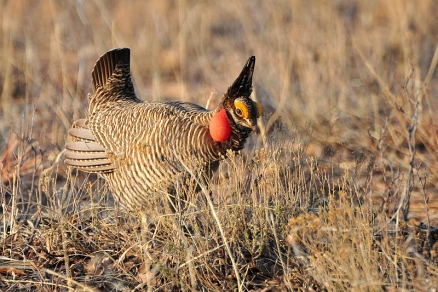
Lesser Prairie Chicken, New Mexicio (Source: By http://www.flickr.com/photos/larry1732/ (http://creativecommons.org/licenses/by/2.0), via Wikimedia Commons)
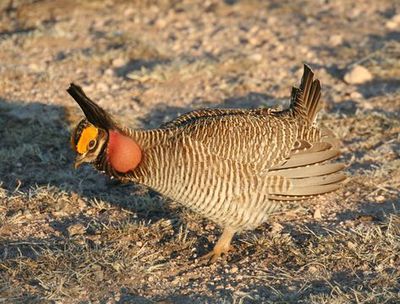 Male lesser prairie chicken. Photo by Kevin Role. Encyclopedia of Life
Male lesser prairie chicken. Photo by Kevin Role. Encyclopedia of Life
Lesser Prairie Chickens (Tympanuchus pallidicinctus) are members of the pheasant family that are found in southeastern Kansas, the panhandles of Oklahoma and Texas, and eastern New Mexico. Male Prairie Chickens gather in leks in open areas where they attemptto attract females by engaging in a distinctive dance and making "booming" calls. Primarily due to habitat loss, Lesser Prairie Chickens are considered to be "vulnerable" on the IUCN List of Threatened Species and were recently listed as "threatened" by the U.S. Fish & Wildlife Service. They are known as Lesser Prairie Chickens because they are slightly smaller than Tympanuchus cupido, the Greater Prairie Chicken.
Contents
Physical Description
The Lesser Prairie Chicken is a small grouse-like bird that weighs between 1.5 and 2 pounds and stands 14 - 16 inches tall as an adult. The bird's plumage is barred with beigeand brown and its tail is short and rounded. The Lesser Prairie Chicken shows sexual dimorphism; males have a yellow-orange comb on the top of their heads, neck feathers, called pinnae, that can be erected to resemble horns, and a pink circular bare patch of skin known as the gular pouch, all of which are lacking in females. Male tail feathers are barred in the center and the terminal feathers are black while the female tail feathers are barred throughout.
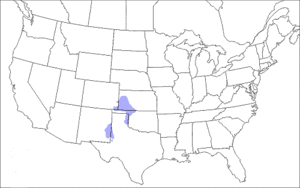 Current distribution of lesser prairie chicken. From USGS
Current distribution of lesser prairie chicken. From USGS
Distribution
Lesser Prairie Chickens are found in western Kansas, southeastern Colorado, the Oklahoma panhandle, the Texas panhandle, and eastern New Mexico, USA. Currently, their range is highly fragmented and they are currently found inonly 14% of their original range.
==
Habitat
Prairie chickens need open grasslands for rearing and feeding, more open and shorter grasslands for booming grounds, and scattered shrub thickets for protection from weather and predators. Lesser Prairie Chickens originally inhabited mid-grass prairie with or without interspersed shinneryoak or sand sagebrush. It is now most commonly found in dwarf shrub-mixed grass vegetation, sometimes interspersed with short grass and, optimally, with some portion (<25%) of the landscape in row grains as supplemental winter forage. A stable winter food source is important so native grasslands mixed with small grain agricultural fields are ideal habitat.
Home Range
Home range size varies according to sex, time of year, and reproductive activity. Females typically nest 1.2-3.4 kilometersfrom a lek. Males typically stay close to the leks so male home ranges tend to smaller than female home ranges. Males exhibit site fidelity, returning to the same lek year after year.
Food Habits
Lesser Prairie Chickens are omnivores whose diets vary depending on location and time of year. The diet of adult Lesser Prairie Chickens is comprised of insects, insect galls, and the seeds, leaves, catkins, and buds of forbs or cultivated crops. Although they prefer to eat small grains such as wheat soybeans, milo, sorghum, and corn, they will also eat alfalfa and the seeds and leaves of other prairie plants.
Juveniles less than 10 weeks old feed primarily on insects such as grasshoppers and beetle, however, leafhoppers and other smaller insects are eaten in the initial weeks after hatching.
Lesser Prairie Chickens obtain most of their water needs from the food they consume.
Mating Behavior and Reproduction
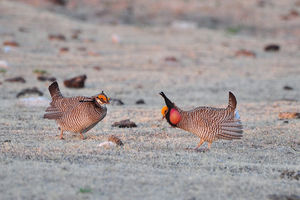 Lesser prairie chicken lek. Photo by Larry Lamsa. Encyclopedia of Earth
Lesser prairie chicken lek. Photo by Larry Lamsa. Encyclopedia of Earth
Male Lesser Prairie Chickens gather together in a lek in an attempt to court females. A lek is a location where males gather to display to females in an attempt to entice the females to mate with them. In prairie chickens, males perform elaborate, competitive mating displays including inflating the air sac on their throats to make a booming sound, showing off the yellow combs above their eyes, raising their dark neck tuts or pinnae to look like horns, and using special calls. The same group of males gather daily during the mating season and fight to establish territories on the lek. Dominant, usually older, males establish territories near the center of the lek and subordinant, usually younger, males are restricted to the edge. Males on leks defend territories ranging in size from less than 40 to more than 150 square meters.
Males will gather on leks in the spring and the fall. Leks are usually located on elevated areas with short vegetation. They have been known to lek on open areas produced by humans.Males begin to display early in the morning and females come to the lek in the spring to find a mate. Generally, femalesonly mate with the dominant males.
Lesser Prairie Chickens at a lek. Video by Noppadol Paothong. www.savethelastdancebook.com
After mating, the females will leave the lek and prepare a nest by scraping outa shallow depression in the soil, which they line with leaves and feathers.Nests are often constructed on north- or northeast-facing slopes, presumably for protection from prevailing southwest winds and direct sunlight Females prefer to nest in relatively tall, dense vegetation; nests are often builtunder sand sagebrush or shinnery oak shrubs.
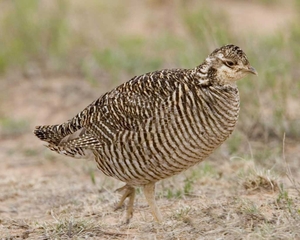 Lesser prairie chicken female. Photo by Rick and Nora Bowers/Vireo
Lesser prairie chicken female. Photo by Rick and Nora Bowers/Vireo
Egg laying begins about two weeks after mating. Females lay one egg per day for a total offrom 8-13 eggs per clutch. Eggs are incubated for 24-26 days before they hatch. Nesting success is low, particularly during warm and dry periods.
Chicksare well-developed at hatching and are able to leave the nest within hours. They grow rapidly and arecapable of attempting short flights as early as two weeks old. Chicks remain with their mothers for 12-15 weeks.
Predators
Lesser Prairie Chickens are preyed upon by a number of mammals, including skunks, weasels, red foxes, and domesticated dogs. Predators also include birds such as raptors, crows, ravens, and magpies, and reptiles such as snakes. The average life expectancy of these birds is about 5 years.
Conservation Status and Threats
The Lesser Prairie Chicken is listed as a "vulnerable" species on the IUCN List of Threatened Species due to long-term decline in population size. Recent studies, (Center for Biological Diversity,2013) estimate the total population of the species to be around 17,000 individuals, which is a 50% decrease from 2012. In March 2014, the U.S. Fish & Wildlife Service listed the Lesser Prairie Chicken as being a "threatened" species under the Endangered Species Act.
The primary threat is habitat loss-fragmentation and degradation-principally due to the conversion of native sand sagebrush and shinnery oak rangeland to cropland and "improved" pastures. Threats also come from overgrazing and brush control.Habitat fragmentation is detrimental for several reasons: fragments may be smaller than the required home range size, necessary habitat diversity may be lost, and the probability of recolonization decreases as distance from nearest patch increases. Fragmentation also renders nests more susceptible to predation. Other important threats include oil production, the introduction of alien species such as ring-necked pheasants, and drought.
References and Further Reading
- Tympahuchus pallidicinctus. Encyclopedia of Life.http://eol.org/pages/1049178/details
- Lesser Prairie Chicken. The Texas Breeding Bird Atlas. http://txtbba.tamu.edu/species-accounts/lesser-prairie-chicken/
- Lesser Prairie Chicken.http://www.biokids.umich.edu/critters/Tympanuchus_pallidicinctus/
- Greater and Lesser Prairie Chicken. Kansas Department of wildlife, Parks and Tourism. http://www.biokids.umich.edu/critters/Tympanuchus_pallidicinctus/
- Lesser Prairie-Chicken. Cornell Lab of Ornithology. http://www.allaboutbirds.org/guide/lesser_prairie-chicken/id
- Lesser Prairie-Chicken. Audubon.http://birds.audubon.org/birds/lesser-prairie-chicken
- Tympanuchus pallidicinctus. The IUCN Red List of Threatened Species. http://www.iucnredlist.org/details/22679519/0
- Effects of Management Practices on Grassland Birds: Lesser Prairie-Chicken. Northern Prairie wildlife Research Center.http://www.npwrc.usgs.gov/resource/literatr/grasbird/lpch/lpch.htm
- New Study Shows Steep Decline of Lesser Prairie Chicken Populations. (2013) Center for Biological Diversity. http://www.biologicaldiversity.org/news/press_releases/2013/lesser-prairie-chicken-09-24-2013.html
- Lesser Prairie-chicken. Ecological Services. US Fish and Wildlife Service (accessed April 23, 2014). https://www.fws.gov/southwest/es/LPC.html
This article was written by a studentat Texas Tech University participating in the Encyclopedia of Earth's Student Science Communication Project. The project encourages students in undergraduate and graduate programs to write about timely scientific issues under close faculty guidance. All articles have been reviewed by internal EoE editors and by independent experts on each topic.